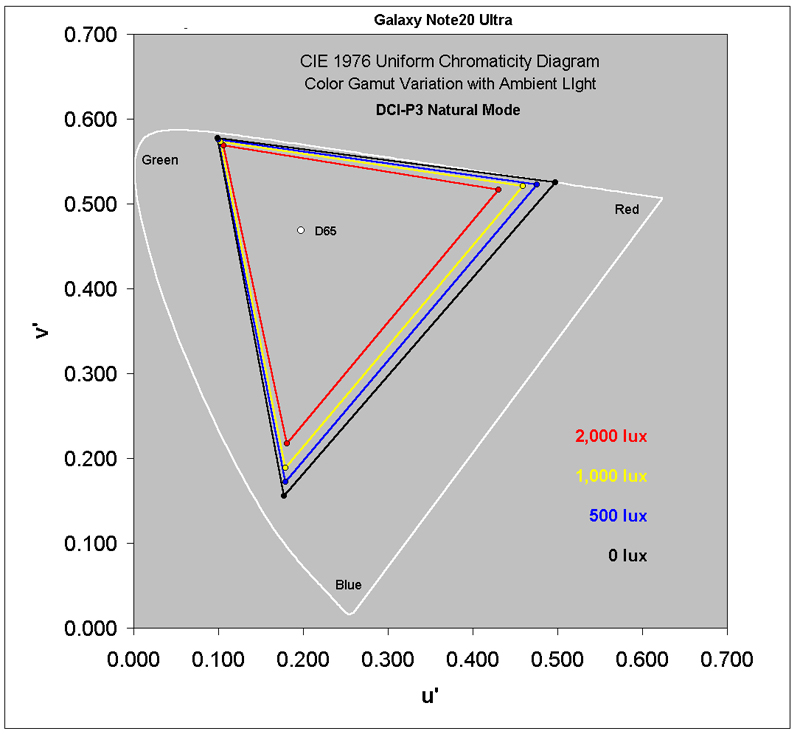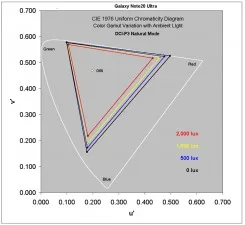Over the last five years the factory display calibration of the best smartphones and TVs has improved to the point where many of them deliver ‘Absolute Color Accuracy’ that is ‘Visually Indistinguishable from Perfect’ based on detailed Laboratory measurements that are documented in my Display Technology Shoot-Out Article Series, which is regularly covered by Display Daily.

That’s very impressive, but that’s only the case when the display is being viewed in absolute darkness (0 lux). However, Smartphones are almost never used in the dark. Most daytime TV viewing is done in significant ambient light, and even high-end home theaters are viewed under enough ambient light to noticeably reduce their outstanding display specs.
So under essentially all normal viewing conditions, displays do not provide the Color Gamut, Contrast Ratio, Color Accuracy, or Intensity Scale Accuracy that they are expected to be producing, and well below their published specs. It’s very similar to the difference between ‘Lab Measured’ and ‘Real World’ road tested mpg for cars.
Real World Ambient Ligh is the Ultimate Challenge
Improving the display performance in actual real world ambient light viewing conditions is the ultimate challenge and the final frontier for displays. It is something that every consumer will benefit from, and will also immediately notice and appreciate – providing a true sales and marketing advantage. It is in my view the single biggest issue facing the display industry, and the single biggest opportunity for getting consumers to want to upgrade their devices…
In ambient light, essentially all that smartphone and TV manufacturers currently do is simply automatically increase the display’s luminance based on the lux level measured by an ambient light sensor next to the display. But there is a lot more that can be done to significantly improve display performance in ambient light.
The key will be in implementing dynamic color management within the software and firmware that can provide automatic real-time modification of both the displayed color gamut and the intensity scale based on the current measured ambient light lux level. This can be accomplished by adding quantitative parametric algorithms that are based on the display’s measured native performance.
This will not only improve the picture quality and accuracy, screen readability and viewing comfort in real world ambient light viewing conditions, but it can then be accomplished using lower luminance settings. That will significantly decrease the used display power and increase the running time on battery for smartphones (and the EPA power efficiency for TVs), because displays typically account for more than 50% of the total device power consumption.
The Galaxy Note20 Ultra Is the Best in Ambient Light
The display on the just launched Galaxy Note20 Ultra effectively provides the best display performance in ambient light of any smartphone or TV, so I’ll use it to demonstrate the main issues. The figures below show the measured variations in the color gamut and intensity scale for the Galaxy Note20 Ultra from 0 lux up through 2,000 lux.
The first figure is for the DCI-P3 color gamut at the maximum standard luminance of 486 nits: At 500 lux, which corresponds to typical office lighting, the measured on-screen color gamut is reduced to 90% of the value at 0 lux. The effect is largest for the red and blue primaries and smallest for green. At 1,000 lux, which corresponds to very bright indoor lighting or outdoor daylight with an overcast sky, the on-screen color gamut decreases to 81%, and at 2,000 lux, which corresponds to typical outdoor daylight in the shade, the on-screen Color Gamut decreases to just 67%. These effects are proportionally larger for lower luminance settings, and for darker content within the image. The dynamic color management can be further improved if the display has more saturated native red and blue primaries that can offset their decrease in ambient light.

The intensity scale figure shows how the image contrast within an image is changed by ambient light, and particularly how dark image content is lost. Again, these effects are proportionally larger when the peak luminance is less than 486 nits. Both the image contrast and the color saturation can be significantly improved by modifying the intensity scale based on the current ambient Light lux level.

Both display and device manufacturers should dedicate their efforts and resources into improving real world display performance in ambient light by using advanced dynamic color management technology to help restore and compensate for the loss of color Gamut, color Saturation, and image contrast due to ambient light, something that every consumer will benefit from, and will also immediately notice and appreciate – providing a true sales and marketing advantage.
The displays, technologies, and manufacturers that succeed in implementing this new real world ambient light performance strategy will take the lead in the next generations of mobile displays, monitors, and TVs. (RS)
The developer of DisplayMate is an internationally recognized research scientist with a distinguished career that spans physics, computer science, and television system design. Dr. Soneira obtained his Ph.D. in Theoretical Physics from Princeton University, spent 5 years as a Long-Term Member of the world famous Institute for Advanced Study in Princeton, another 5 years as a Principal Investigator in the Computer Systems Research Laboratory at AT&T Bell Laboratories, and has designed, tested, and installed color television broadcast equipment for the CBS Television Network Engineering and Development Department. He has authored over 35 research articles in scientific journals in physics and computer science, including Scientific American.
[email protected]

